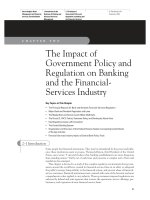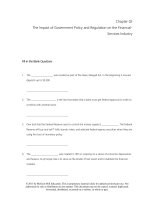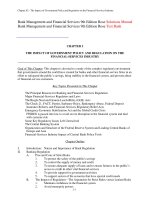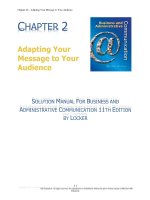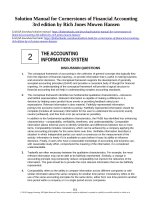Solution manual bank management and financial services 9th edition by rose, peter chap016
Bạn đang xem bản rút gọn của tài liệu. Xem và tải ngay bản đầy đủ của tài liệu tại đây (108.09 KB, 13 trang )
Chapter 16 - Lending Policies and Procedures: Managing Credit Risk
CHAPTER 16
LENDING POLICIES AND PROCEDURES: MANAGING CREDIT RISK
Goal of This Chapter: The purpose of this chapter is to learn the steps in a lending process,
regulations in the industry, and the importance of lending policies for banks and other lending
institutions.
Key Topics in This Chapter
Types of Loans Banks and Competing Lenders Make
Factors Affecting the Mix of Loans Made
Regulation of Lending
Creating a Written Loan Policy
Steps in the Lending Process
Loan Review and Loan Workouts
Chapter Outline
I. Introduction
II. Types of Loans
A. Types of Loans:
1. Real Estate Loans
2. Financial Institution Loans
3. Agricultural Loans
4. Commercial and Industrial Loans
5. Loans to Individuals
6. Miscellaneous Loans
7. Lease Financing Receivables
B. Factors Determining the Growth and Mix of Loans
III. Regulation of Lending
A. Relevant Regulations:
B. Establishing A Good Written Loan Policy
IV. Steps in the Lending Process
1. Finding Prospective Loan Customers
2. Evaluating a Prospective Customer’s Character and Sincerity of Purpose
3. Making Site Visits and Evaluating a Prospective Customer’s Credit Record
4. Evaluating a Prospective Customer’s Financial Condition
5. Assessing Possible Loan Collateral and Signing the Loan Agreement
6. Monitoring Compliance with the Loan Agreement and Other Customer Service
Needs
V. Credit Analysis: What Makes a Good Loan?
A. Is the Borrower Creditworthy? The Cs of Credit
16-1
Chapter 16 - Lending Policies and Procedures: Managing Credit Risk
1. Character
2. Capacity
3. Cash
4. Collateral
5. Conditions
6. Control
B. Can the Loan Agreement Be Properly Structured and Documented?
C. Can the Lender Perfect Its Claim Against the Borrower's Earnings and Any Assets
That May Be Pledged as Collateral?
1. Reasons for Taking Collateral
2. Common Types of Loan Collateral
a. Accounts Receivable
b. Factoring
c. Inventory
d. Real Property
e. Personal Property
f. Personal Guarantees
3. Other Safety Devices to Protect a Loan
VI. Sources of Information About Loan Customers
VII. Parts of A Typical Loan Agreement
A. The Promissory Note
B. Loan Commitment Agreement
C. Collateral
D. Covenants (Affirmative and Negative)
E. Borrower Guaranties or Warranties
F. Events of Default
VIII. Loan Review
IX. Loan Workouts
X. Summary of the Chapter
Concept Checks
16-1. In what ways does the lending function affect the economy of its community or region?
Bank credit is one of the most important sources of capital that fuels local economic growth and
development. When banks make loans to support the development of new businesses and to aid
the growth of existing businesses, new jobs are created and there is a greater flow of income and
spending throughout the local economy.
16-2. What are the principal types of loans made by banks?
Bank loans are usually classified by the purpose of the loans. The most common classifications
are real estate loans, commercial and industrial loans, loans to financial institutions, credit-card
and other loans to individuals, lease financing, and agricultural loans. Bank loans may also be
classified by maturity—short term, medium-term, and long-term loans.
16-2
Chapter 16 - Lending Policies and Procedures: Managing Credit Risk
16-3. What factors appear to influence the growth and mix of loans held by a lending
institution?
The particular mix of any lending institution's loan portfolio is shaped by the characteristics of its
market area, the expected yield and cost associated with each type of loan, loan participations,
size of the lending institution, experience and expertise of the management, the institution’s
written loan policy, expected yields, and regulations.
16-4 A lender's cost accounting system reveals that its losses on real estate loans average 0.45
percent of loan volume and its operating expenses from making these loans average 1.85 percent
of loan volume. If the gross yield on real estate loans is currently 8.80 percent, what is this
lender's net yield on these loans?
The bank's net yield on real estate loans is gross yield as reduced by costs associated with the
loans:
Therefore, net yield on real estate loans will be: 8 - 0.45 + 1.85 = 6.45%
16-5. Why is lending so closely regulated by state and federal authorities?
Access to credit for individuals and businesses is quintessential for any economy. However,
irrational lending can sometimes result in huge bad loans for the lending institutions. If a lender
is under capitalized, it may even lead to bankruptcy during stressed economic conditions.
Empirical evidences suggest that liquidity in banking sector is severely affected due to cascading
effects and it takes a long time before free-flow of credit returns in the industry. This has direct
fallout on the health of the economy. Regulation also protects consumers against discrimination.
Therefore, it is essential that the lending institutions be closely regulated.
16-6. What is the CAMELS rating and how is it used?
CAMELS is a rating system used by federal bank examiners to evaluate the overall health of a
bank. It is an abbreviation for each of the six factors used to assess the bank. The letters in the
word are derived from—Capital adequacy, Asset quality, Management quality, Earnings record,
Liquidity position, and Sensitivity to market risk.
16-7. What should a good written loan policy contain?
A good written bank loan policy should contain the characteristics and goals of the loan
portfolio, the authorities and responsibilities of loaning officers, and clearly laid down operating
procedures for loaning funds. It should provide details of the required documentation and
collateral. It should define an institution’s principal trade area, maximum lending with respect to
the institution’s capital, minimum acceptable credit ratings, and the process of determination of
interest rates chargeable. Methods of dealing with non-performing assets should also be included
in the policy.
16-8. What are the typical steps followed in receiving a loan request from a customer?
16-3
Chapter 16 - Lending Policies and Procedures: Managing Credit Risk
A loan officer usually takes or receives such a request initially and passes it along to the credit
analysis division for technical review. Usually the recommendations of both the credit analyst
and the loan officer are directed to a loan supervisor or loan committee for approval. The loan
committee assesses the possible loan collaterals offered and decides on whether to approve the
customer’s request. Once approved, the loan committee must monitor to ensure that the terms of
the loan are being followed and to address any other service needs that the customer may have.
16-9. What three major questions or issues must a lender consider in evaluating nearly all loan
requests?
The key issues that a lender must consider while evaluating any loan request are:
1. Is the borrower creditworthy?
2. Can the loan agreement be properly structured and documented?
3. Can the lender perfect its claim against the borrower's earnings and any assets that may
be pledged as collateral?
16-10. Explain the following terms: character, capacity, cash, collateral, conditions, and control.
a. Character – Character assessment involves finding out the purpose of credit request by a
customer and the intention of the borrower to repay the funds.
b. Capacity – Capacity is a customer’s authority to request a loan and the legal standing to sign a
binding loan agreement.
c. Cash – Cash is the ability of a customer to generate sufficient cash flows to service the
principal and interest amount on the loan as and when they become due.
d. Collateral – Collateral refers to an asset pledged by a borrower as a security with the lending
institution against loaned funds.
e. Conditions – Conditions refer to the current economic situations in the borrower’s line of
work. This is important because the ability of the borrower to generate cash flows may be
affected by change in conditions.
f. Control – The control element refers to considerations regarding the impact of changes in law
and regulation that can adversely affect the borrower and whether the loan request meets the
lender’s and the regulatory authorities’ standards for loan quality.
16-11. Suppose a business borrower projects that it will experience net profits of $2.1 million,
compared to $2.7 million the previous year, and will record depreciation and other noncash
expenses of $0.7 million this year versus $0.6 million last year. What is this firm’s projected cash
flow for this year? Is the firm’s cash flow rising or falling? What are the implications for a
lending institution thinking of loaning money to this firm? Suppose sales revenue rises by $0.5
million, cost of goods sold decreases by $0.3 million, while cash tax payments increase by $0.1
16-4
Chapter 16 - Lending Policies and Procedures: Managing Credit Risk
million and noncash expenses decrease by $0.2 million. What happens to the firm’s cash flow?
What would be the lender’s likely reaction to these events?
(Note: Assume the noncash expense is already included in the cost of goods sold.)
The firm's projected cash flow can be estimated by adding non-cash expenses (depreciation) to
its net income.
Cash flow of the firm in the previous year: $2.7 + $0.6 = $3.3 million.
Expected cash flows in the current year: $2.1 + $0.7 = $2.8 million
Clearly the firm's cash flow is falling. The lending institution needs to find out the reasons for
this decline before committing any funds.
Under the new scenario, the implications for the cash flows would be:
Sales revenue
Costs of goods sold
Cash tax payments
Noncash expenses
Total
$0.50
0.30
-0.10
-0.20
$0.70
Since the cash flows for the firm have risen by $0.5 million, it should be more comforting for the
lender to loan out funds to the borrower.
16-12. What sources of information are available today that loan officers and credit analysts can
use in evaluating a customer loan application?
Lending institutions, nowadays, have access to multiple sources of information that they can use
to evaluate a loan application from a customer. For corporates, financial statements supplied by
the borrower, ratings provided by credit rating agencies, and industry-wide performance ratios
for comparison purposes supplied by such organizations as Dun and Bradstreet and Risk
Management Associates (RMA) are widely used. For individuals, a lender can contact the one of
the various credit bureaus to find out a customer’s credit history of a customer. The lending
institution may also contact other lenders to determine their experience with the borrowing
customer.
16-13. What are the principal parts of a loan agreement? What is each part designed to do?
The most important parts of loan agreements include a promissory note, a loan commitment
agreement, collateral, covenants, and a section listing events of default.
A promissory note states the principal amount, the interest rate, and the terms of the loan. A loan
commitment agreement is a document in which the lender promises to make the loan available to
the borrower over a designated future period up to a maximum amount in return for a
commitment fee. Covenants specify what the borrower must and must not do. Collateral refers to
the assets pledged by the borrower to protect the lender’s interests. A listing of events of default
16-5
Chapter 16 - Lending Policies and Procedures: Managing Credit Risk
states the actions that the lender of the loan is legally authorized to take in order to secure the
funds in the event of default by the borrower.
16-14. What is loan review? How should a loan review be conducted?
Loan review is a process of periodic review of outstanding loans on an institution's books to
make sure each loan is paying out as planned, all necessary documentation is present, and the
bank's loan officers are following the institution's loan policy. It also involves regularly
reviewing a borrower’s financial health which may change as a result of change in economic
variables. The exercise helps senior management and the bank's board of directors in assessing
the overall exposure to risk and its possible need for more capital in the future. While lending
institutions today use a variety of different loan review procedures, few general procedures that
are followed by nearly all lending institutions include:
1. Carrying out reviews of all types of loans on a periodic basis
2. Structuring the loan review process carefully to make sure the most important features
of each loan are checked
3. Reviewing the largest loans most frequently
4. Conducting more frequent reviews of troubled loans
5. Accelerating the loan review schedule if the economy slows down or if industries in
which the bank has made a substantial portion of its loans develop significant problems
16-15. What are some warning signs to management that a problem loan may be developing?
Loans characterized by reduced communication between borrower and lender, delays in
receiving financial reports, evidence of revaluations of assets (such as inventory or pension-plan
assets), declining stock prices, changes in management, consistently declining profits, change in
credit rating, or restructuring of other loans the borrower has taken out are often considered as
indications of a developing problem loan.
16-16. What steps should a lender go through in trying to resolve a problem loan situation?
While workout of each problem loan may depend on the circumstances due to which the loan has
turned underperformer, some of the common steps involved include:
1. The goal of all loan workouts should be to maximize the chances of recovery of funds.
2. Problems with any loans should be quickly detected and reported.
3. Loan workout process should be independent of the lending function to avoid any
conflict of interest.
4. Loan workout specialists should conduct a preliminary analysis of the problem and its
possible causes and confer with the troubled customer quickly on the possible options,
including any financial and operational restructuring.
5. A preliminary plan of action should be developed after determining the risk exposure,
sufficiency of loan documents, and estimated liquidation values of assets and deposits.
6. Loan workout personnel should conduct a tax and litigation search to check for any other
unpaid liabilities of the borrower.
16-6
Chapter 16 - Lending Policies and Procedures: Managing Credit Risk
7. For business borrowers, loan personnel must evaluate the quality, competence, and
integrity of current management.
8. Loan workout professionals must consider all reasonable alternatives for cleaning up the
troubled loan including an option to seek a revised loan agreement.
Problems & Projects
16-1. The lending function of depository institutions is highly regulated and this chapter gives
some examples of the structure of these regulations for national banks. In this problem you are
asked to apply those regulations to Red Rose National Bank (RRNB). Red Rose has the
following sources of funds: $300 million in capital and surplus, $325 million in demand deposits,
$680 million in time and savings deposits, and $200 million in subordinated debt.
a. What is the maximum dollar amount of real estate loans that RRNB can grant?
The total volume of real estate loans granted by a U.S. national bank cannot exceed that bank’s
capital and surplus or 70 percent of its total time and savings deposits whichever is higher.
Capital and surplus: $300 million
70 percent of time and savings deposit: $680 × 70 percent = $476 million
Therefore, maximum amount of real estate loans that RNRB can grant is $476 million.
b. What is the maximum dollar amount RRNB may lend to a single customer?
A depository institution can provide an unsecured loan of a maximum of 15 percent of its
unimpaired capital to a single customer. This can be further extended by another 10 percent if the
loan amount exceeding 15 percent is fully secured by marketable securities.
Therefore, maximum amount of unsecured that RNRB can provide to a single customer is:
$300 × 15% = $45 million.
A further amount of $300 × 10% = $30 million can be loaned against fully secured marketable
securities.
16-2. Motivation Corporation, seeking renewal of its $12 million credit line, reports the data in
the following table (in millions of dollars) to Hot Springs National Bank’s loan department.
Please calculate the firm’s cash flow as defined earlier in this chapter. What trends do you
observe, and what are their implications for the decision to renew or not renew the firm’s line of
credit?
Projections for
20X1 20X2 20X3 20X4
Next Year
Costs of Goods Sold
$5.1 $5.5 $5.7 $5.8
$6.0
Selling and Admin Exp.
$8.0 $8.0 $8.0 $8.1
$8.2
Sales Revenue
$7.9 $8.5 $9.2 $9.4
$9.8
Depreciation and other noncash expenses $11.2 $11.2 $11.1 $11.0
$11.0
Taxes Paid in Cash
$4.4 $4.6 $4.9 $4.8
$4.8
16-7
Chapter 16 - Lending Policies and Procedures: Managing Credit Risk
(Note: Assume the noncash expense is already included in the cost of goods sold.)
Cash flows for a firm can be calculated as:
Sales Revenues - Cost of Goods Sold - Selling and Admin - Taxes Paid in Cash + Non Cash Expenses
Therefore, the cash flows for Motivation Corporation for each year will be:
Year
20X1
20X2
20X3
20X4
Projections for Next Year
Cash Flow
$1.60
$1.60
$1.70
$1.70
$1.80
Cash flows for the firm have been rising steadily, suggesting that the firm would have less
trouble making required loan payments. The lender, though, needs to check if the projections for
next year seem reasonable since borrowers are sometimes over optimistic about future
opportunities. However, if the projections are reasonable, Hot Springs National Bank may
consider renewing the loan.
16-3. Parvis Manufacturing and Service Company holds a sizable inventory of dryers and
washing machines, which it hopes to sell to retail dealers over the next six months. These
appliances have a total estimated market value currently of $30 million. The firm also reports
accounts receivable currently amounting to $24,650,000. Under the guidelines for taking
collateral discussed in this chapter, what is the minimum size loan or credit line Parvis is likely to
receive from its principal lender? What is the maximum size loan or credit line Parvis is likely to
receive?
For advances against accounts receivables, a lender takes a security interest in the form of a
stated percentage usually between 40 to 90 percent of the face amount, depending upon the
perceived quality of the receivables while for advances against inventories, a lender will usually
advance only 30 to 80 percent of the estimated market value of a borrower's inventory to leave a
substantial cushion in case of decline in the inventory's value.
Therefore, the minimum size loan or credit line for Parvis will be:
$30 × 0.3 + $24.65 × 0.4 = $18.86 million
And the maximum size loan or credit line for Parvis will be:
$30 × 0.8 + $24.65 × 0.9 = $46.185 million
16-4. Under which of the six Cs of credit discussed in this chapter does each of the following
pieces of information belong?
The particular C of credit represented by each piece of information presented in this problem was
as follows:
a. First National Bank discovers there is already a lien against the fixed assets of one of its
customers asking for a loan.
16-8
Chapter 16 - Lending Policies and Procedures: Managing Credit Risk
Collateral
b. Xron Corporation has asked for a type of loan its lender normally refuses to make.
Control
c. John Selman has an excellent credit rating.
Character
d. Smithe Manufacturing Company has achieved higher earnings each year for the past six years.
Cash
e. Consumers Savings Association’s auto loan officer asks a prospective customer, Harold Ikels,
for his driver’s license.
Capacity
f. Merchants Center National Bank is concerned about extending a loan for another year to
Corrin Motors because a recession is predicted in the economy.
Conditions
g. Wes Velman needs an immediate cash loan and has gotten his brother, Charles, to volunteer to
cosign the note should the loan be approved.
Character
h. ABC Finance Company checks out Mary Earl’s estimate of her monthly take-home pay with
Mary’s employer, Bryan Sims Doors and Windows.
Cash
i. Hillsoro Bank and Trust would like to make a loan to Pen-Tab Oil and Gas Company but fears
a long-term decline in oil and gas prices.
Conditions
j. First State Bank of Jackson seeks the opinion of an expert on the economic outlook in Mexico
before granting a loan to a Mexican manufacturer of auto parts.
Control
k. The history of Membres Manufacture and Distributing Company indicates the firm has been
through several recent changes of ownership and there has been a substantial shift in its principal
suppliers and customers in recent years.
Capacity
l. Home and Office Savings Bank has decided to review the insurance coverages maintained by
its borrowing customer, Plainsman Wholesale Distributors.
Collateral
16-5. Butell Manufacturing has an outstanding $11 million loan with Citicenter Bank for the
current year. As required in the loan agreement, Butell reports selected data items to the bank
16-9
Chapter 16 - Lending Policies and Procedures: Managing Credit Risk
each month. Based on the following information, is there any indication of a developing problem
loan? About what dimensions of the firm’s performance should Citicenter Bank be concerned?
Cash account (millions of dollars)
Projected sales (millions of dollars)
Stock price per share
(monthly average)
Capital structure (equity/debt ratio
in percent)
Liquidity ratio (current assets/
current liabilities)
Earnings before interest and taxes
(EBIT; in millions of dollars)
Return on assets (ROA; percent)
Sales revenue (millions of dollars)
One
Two
Current
Month Months
Month
Ago
Ago
$33
$57
$51
$298
$295
$294
Three
Months
Ago
$44
$291
Four
Months
Ago
$43
$288
$6.60
$6.50
$6.40
$6.25
$6.50
32.8%
33.9%
34.6%
34.9%
35.7%
1.10x
1.23x
1.35x
1.39x
1.25x
$15
3.32%
$290
$14
3.25%
$289
$13
2.98%
$290
$11
3.13%
$289
$13
3.11%
$287
Butell has announced within the past 30 days that it is switching to new methods for calculating
depreciation of its fixed assets and for valuing inventories. The firm’s board of directors is
planning to discuss at its next meeting a proposal to reduce stock dividends in the coming year.
Selected items reported to the bank by the company do indicate the possible development of a
problem loan situation. For one thing, Butell's cash account has fallen sharply in the latest month
after several months of a substantial uptrend and the firm's liquidity ratio of current assets to
current liabilities has declined significantly in the last 3 months. Decreases in the firm's liquidity
position may be signaling difficulty in maintaining enough cash to meet near-term liabilities.
Another possible cause for concern centers around Butell's capital structure as its ratio of equity
capital relative to debt financing is falling, indicating that creditors (including Citicenter Bank)
are providing a larger share of the firm's capitalization. Raising fixed cost capital amidst falling
liquidity implies rising risk for the creditors. However, these changes in liquidity and capital
structure may only reflect normal seasonal pressures and may not be real problems for the bank,
especially because other fundamental aspects of Butell's recent performance—its stock price,
earnings before interest and taxes, and ROA seem to be improving.
Perhaps of greater moment is the decline of sales revenue below Butell's projections. As of the
latest month sales revenue reached $290 million versus a projection of $298 million. Citicenter
Bank must determine the causes of this sales shortfall to see if the firm is encountering
increasing resistance to sales for any of its product lines. However, even this trend may not be a
cause for alarm because sales may well be highly volatile in the industry in which Butell
16-10
Chapter 16 - Lending Policies and Procedures: Managing Credit Risk
operates. The bank's loan officer needs to review the customer's earlier sales projections and
actual sales revenue to determine if there is a real cause for concern.
Butell has indicated a recent switch in inventory and depreciation accounting methods.
Citicenter's loan officer would do well to inquire into the reasons for these changes because they
may reflect an attempt by the firm to offset actual or potential future losses in some aspect of its
operations.
16-6. Identify which of the following loan covenants are affirmative and which are negative
covenants:
a. Nige Trading Corporation must pay no dividends to its shareholders above $3 per share
without express lender approval.
Restrictions on payment of dividends represent negative loan covenants.
b. HoneySmith Company pledges to fully insure its production line equipment against loss due to
fire, theft, or adverse weather.
A requirement to insure selected assets is an affirmative loan covenant.
c. Soft-Tech Industries cannot take on new debt without notifying its principal lending institution
first.
Restrictions against taking on new debt represent negative loan covenants.
d. PennCost Manufacturing must file comprehensive financial statements each month with its
principal bank.
The requirement of filing periodic financial statements with the bank is an affirmative
loan covenant.
e. Dolbe King Company must secure lender approval prior to increasing its stock of fixed assets.
A requirement of securing bank approval before adding to a borrower's stock of fixed
assets is considered a negative loan covenant.
f. Crestwin Service Industries must keep a minimum current (liquidity) ratio of 1.5× under the
terms of its loan agreement.
Requiring a borrowing customer to maintain a current ratio—a liquidity measure—no
lower than 1 .5× is an affirmative loan covenant.
g. Dew Dairy Products is considering approaching Selwin Farm Transport Company about a
possible merger but must first receive lender approval.
The stipulation that prior bank approval of a proposed merger must be obtained is a
negative loan covenant.
16-7. Please identify which of the basic Cs of lending—character, capacity, cash, collateral,
conditions, and control—applies to each of the loan factors listed here:
16-11
Chapter 16 - Lending Policies and Procedures: Managing Credit Risk
Insurance coverage
Competitive climate for customer’s product
Credit rating
Corporate resolution
Liquid reserves
Asset specialization
Driver’s license
Expected market share
Economists’ forecasts
Business cycle
Performance of comparable firms
Guarantees/warranties
Expense controls
Inventory turnover
Projected cash flow
Experience of other lenders
Social Security card
Price-earnings ratio
Industry outlook
Future financing needs
Asset liquidation
Inflation outlook
Adequate documentation
Changes in accounting standards
Written loan policy
Coverage ratios
Purpose of loan
Laws and regulations that apply to the making of loans
Wages in the labor market
Changes in technology
Obsolescence
Liens
Management quality
Leverage
History of firm
Customer identity
Payment record
Partnership agreement
Accounts receivable turnover
Accounts payable turnover
The particular C of lending which applies to each loan factor is listed below:
Character
Capacity
Cash
Collateral
Conditions
Control
Credit rating
Corporate
resolution
Liquid
reserves
Insurance
coverage
Competitive
climate for
Adequate
customers product documentation
Experience of
other lenders
Driver’s
license
Expense
controls
Asset
specialization
Expected market
share
Written loan
policy
Purpose of loan
Social
security card
Inventory
turnover
Guarantees
and warrantees
Business cycle
Changes in
accounting
standards
16-12
Chapter 16 - Lending Policies and Procedures: Managing Credit Risk
History of
Payment record firm
Management
Customer
quality
identity
Partnership
agreement
Projected
Asset
cash flows
liquidation
Price earnings Changes in
ratio
technology
Coverage
ratios
Obsolescence
Leverage
Liens
Performance of
comparable firms
Industry outlook
Inflation outlook
Wages in the
labor market
Accounts
Receivables
Turnover
Economists’
Forecasts
Accounts
Payable
Turnover
Future financing
needs
16-13
Laws and
regulations
that apply to
the making of
loans

